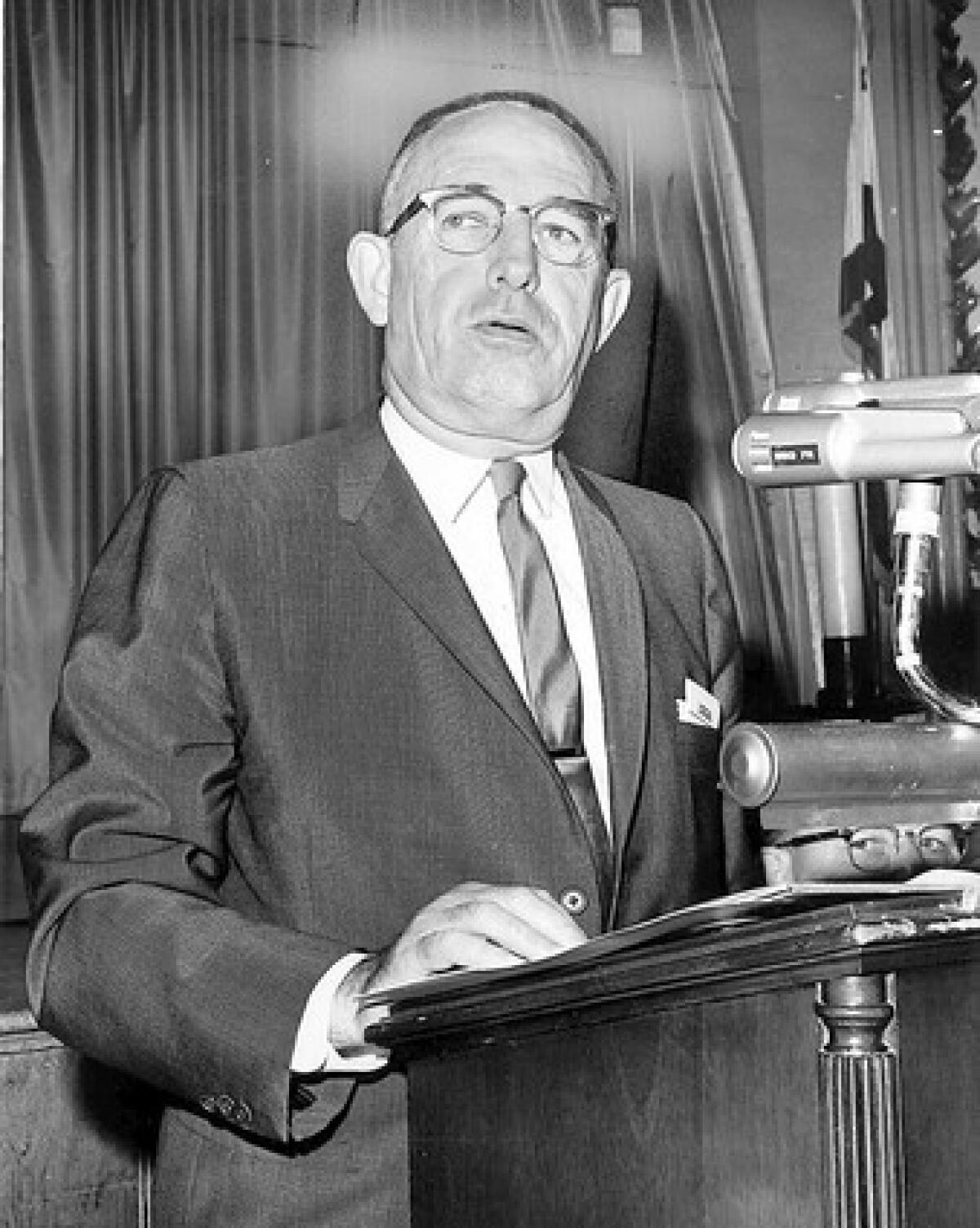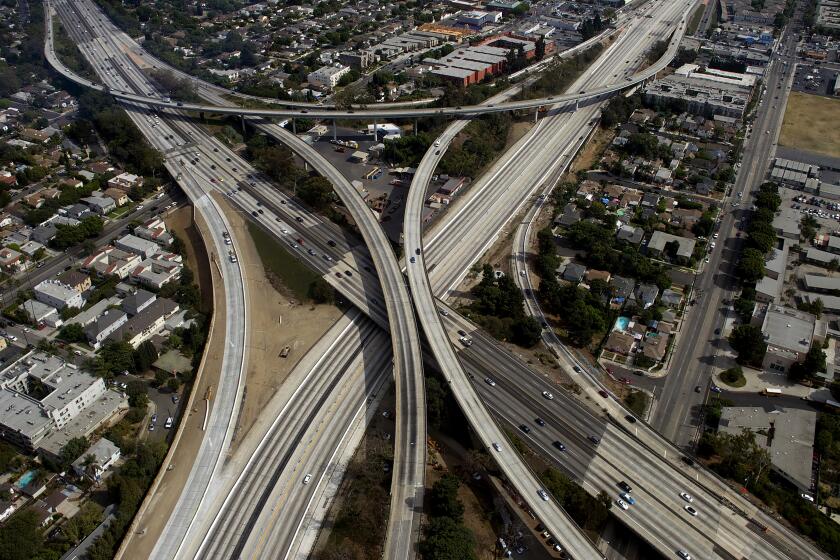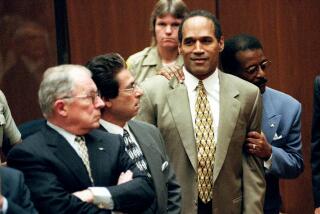Opinion: How white people used police to make L.A. one of the most segregated cities in America

In the summer of 1948, more than 60 residents of the all-white community of Eagle Rock descended upon a home that was poised to sell to a Black family, breaking the neighborhood’s color barrier. The group contained some of the area’s most esteemed businessmen and homeowners, as well as a uniformed police officer. But this was no welcoming party. Upon arrival, the mob set a 12-foot cross aflame and watched it burn.
The timing of the cross burning was not coincidental. It happened shortly after the Supreme Court’s Shelley vs. Kraemer decision made racial covenants — which barred Black, Latino and other people of color from living in certain homes by deed — unenforceable by law. A key legal protection for state-sanctioned segregation had fallen.
Eagle Rock’s message to Black people looking to integrate exclusively white neighborhoods in the wake of the decision was clear: You are not wanted, and the law will not protect you.
This kind of explicit act of racial terror may sound like something out of the Deep South, not liberal Los Angeles. But, as historians have shown, Jim Crow-style residential segregation was the norm, enforced by white communities, lending institutions, real estate agents and compliant police departments.
The Los Angeles Police Department was one such accomplice. And engaging in racial terror was just part of its corruption racket. Bribes and kickbacks were routine. As was police brutality.
Spewing carbon monoxide across L.A. on the freeway system feeds into a pot of racism and segregation that’s been stewing for nearly a century.
In 1950, two years after the Eagle Rock cross burning, William H. Parker was brought on board as chief of the LAPD with promises to professionalize the department and end its culture of corruption. According to former LAPD Chief Ed Davis, Parker would “put his own mother in jail if he had to” in his push to make Los Angeles a law-abiding place, policed by law-abiding officers.
And yet, as detailed in Alisa Sarah Kramer’s “William H. Parker and the Thin Blue Line,” when it came to crimes of racial bias, L.A. most certainly did not change under Parker’s leadership — and neither did his LAPD.
In the first 15 years of Parker’s tenure as chief, there were 100 documented incidents of white supremacist racial violence in Los Angeles. None were brought to justice by Parker’s LAPD. Parker largely refused to hire Black police officers, and those already on the force were prohibited from having white partners for most of Parker’s tenure. According to Kramer, his officers enforced the racial boundaries of segregated Los Angeles, harassing and beating Black and Latino people who strayed too far into white-dominated communities.
As then-LAPD Officer Glenn Souza described the department under Parker: “The Los Angeles Police Department was completely segregated and by any definition extremely racist. ... Black people could not venture north of Beverly or much west of La Brea after dark without a strongly documented purpose.”
The LAPD’s racial animus during this time is often attributed to the bigotry of its chief. Parker was a cartoonish racist who likened Black people to monkeys and thought Latinos inherently criminal due to their descent from what he called the “wild tribes” of Mexico. He once complained during a television news interview that an influx of African Americans moving to L.A. to escape the Jim Crow South had “flooded a community that wasn’t prepared to meet them. We didn’t ask these people to come here.”
According to Kramer, Parker was a punch-below-the-belt politician who maintained his authority in part by spying on his adversaries and threatened them with the dirt he uncovered. Yet he wasn’t some rogue white supremacist who slipped through the cracks into his position. Parker enjoyed strong support from L.A.’s white business leaders and homeowners. Even after the brutality of his department drew national scrutiny in the wake of the 1965 Watts riots, Parker’s white base of support rallied around him. It took death, not outrage, to finally remove him from his position in 1966, after which city leaders changed the name of LAPD headquarters to honor him — and kept it there until 2009.
Parker’s LAPD, much like other problematic police departments across California, was possible only because of the support of the white power structure. And that power structure wanted residential segregation.
L.A.’s powerful real estate industry, as detailed in Andrea Gibson’s “City of Segregation,” did everything it could to enforce and profit from segregation. According to Gibson, the industry furthered the myth that Black and Latino integration was bad for property values, thus ensuring a premium on homes in white communities, while simultaneously imposing artificial scarcity in segregated ones, driving up prices for jam-packed residents of color who were prevented from living elsewhere.
Local and state authorities, meanwhile, used freeway construction to gut Black and Latino communities, creating physical barriers that made any non-white presence on the white side of the road conspicuous — and thus easier to target by law enforcement. These freeways enabled L.A.’s car-dependent suburbs to expand outward, and did so under the guidance of federal, state and local policies explicitly designed to keep those neighborhoods white-only.
This was all done with the complicity of many everyday white Californians, who were happy to sit back and watch their property values skyrocket. In 1964, white homeowners overwhelmingly supported Proposition 14, which made overt housing discrimination part of the state’s Constitution. The measure allowed property owners — essentially meaning white people, who through discriminatory policies controlled most of California’s real estate — to refuse to rent or sell property “to any person as he chooses.”
California’s then-Gov. Edmund G. Brown warned voters that ratifying Proposition 14 would enshrine into the state’s Constitution “a provision for discrimination of which not even Mississippi or Alabama can boast.”
No matter. It was even more popular in Los Angeles County than it was statewide, attracting 70% of the county’s vote.
Proposition 14 laid bare the shameless lengths white Californians were willing to go to prevent people of color, particularly African Americans, from becoming their neighbors.
A half-century later, Los Angeles is known as one of America’s great liberal bastions, yet it remains the most segregated city in the country for Latinos and the 10th most segregated for Black people. Black and Latino children in Los Angeles are less likely to live in integrated neighborhoods than adults — meaning we’re actively backsliding on racial equality.
The reasons for continued segregation decades after the passage of federal civil rights legislation are complicated. But, suffice it to say, policing played a role — and continues to play one to this day, as documented by a recent New York University Law Review report by Monica Bell. And just like with William H. Parker’s LAPD, much of the momentum for police-enabled segregation comes from white communities.
A 2018 UCLA study of L.A. County’s Antelope Valley by Rahim Kurwa found that majority-white areas upset by Black people with Section 8 housing vouchers moving into their neighborhoods “use policing to evict Black neighbors and reassert segregation.” They do so, Kurwa wrote, by intensely monitoring Black residents and calling police for anything they perceive an infraction of neighborhood norms: too many cars in a driveway; loud music; too many houseguests.
These nuisance calls aren’t just harassing. Kurwa found that because of highly restrictive federal housing regulations, the discovery of something as inconsequential as “an extra toothbrush in the bathroom” can lead to eviction because it might indicate an unauthorized occupant.
Even if no infractions are found, police being called to a home in and of itself can often be used as grounds for eviction. Kurwa said in an interview that many of the white homeowners he spoke with for his study were aware of this reality — and made no bones about trying to get their Black neighbors unjustly evicted.
“Voucher programs can be undone by neighborhood hostility,” he said. “Segregation has moved from institutional to individual.”
If Black tenants in white spaces face the constant threat of harassment and eviction, the consequence of living in a segregated Black community is an elevated threat of violence.
A 2018 Boston University study found that states with high levels of structural racism — especially residential segregation — have correspondingly high rates of deadly police shootings of unarmed Black people. California was the 10th most racist state on the study’s index.
A follow-up study found that the correlation between segregation and violence holds true on the city level as well. Notably, the racial makeup of the police officers involved plays almost no role in the shootings the authors examined.
“Violence is deeply ingrained in the way we’ve structured our neighborhoods,” the study’s senior author, Michael Siegel, said in an interview. “Changes can’t just be made at the police level. We need to integrate our communities better.”
Racial integration, of course, takes time. In the interim, police reforms are badly needed to prevent further loss of life and liberty. But data, and history, suggest that these reforms alone will not create the systemic changes needed to protect Black lives.
In Los Angeles and elsewhere, we can’t talk about police brutality in the present without acknowledging our long history of segregation — and how many of the mechanisms used to enforce that segregation have endured, long after laws that buttressed them were repealed.
We see that toxic past alive today in every racially paranoid conversation on Nextdoor. In every call to the police against a Black person for going about his or her daily activities. And especially in our segregated schools and neighborhoods that don’t look a whole lot different than they did in 1964 as far as Black and Latino people are concerned.
Police brutality didn’t just spring from the racist minds of powerful men such as William H. Parker. It reflected the will of white people to segregate.
To an uncomfortable extent, it still does.
More to Read
A cure for the common opinion
Get thought-provoking perspectives with our weekly newsletter.
You may occasionally receive promotional content from the Los Angeles Times.








